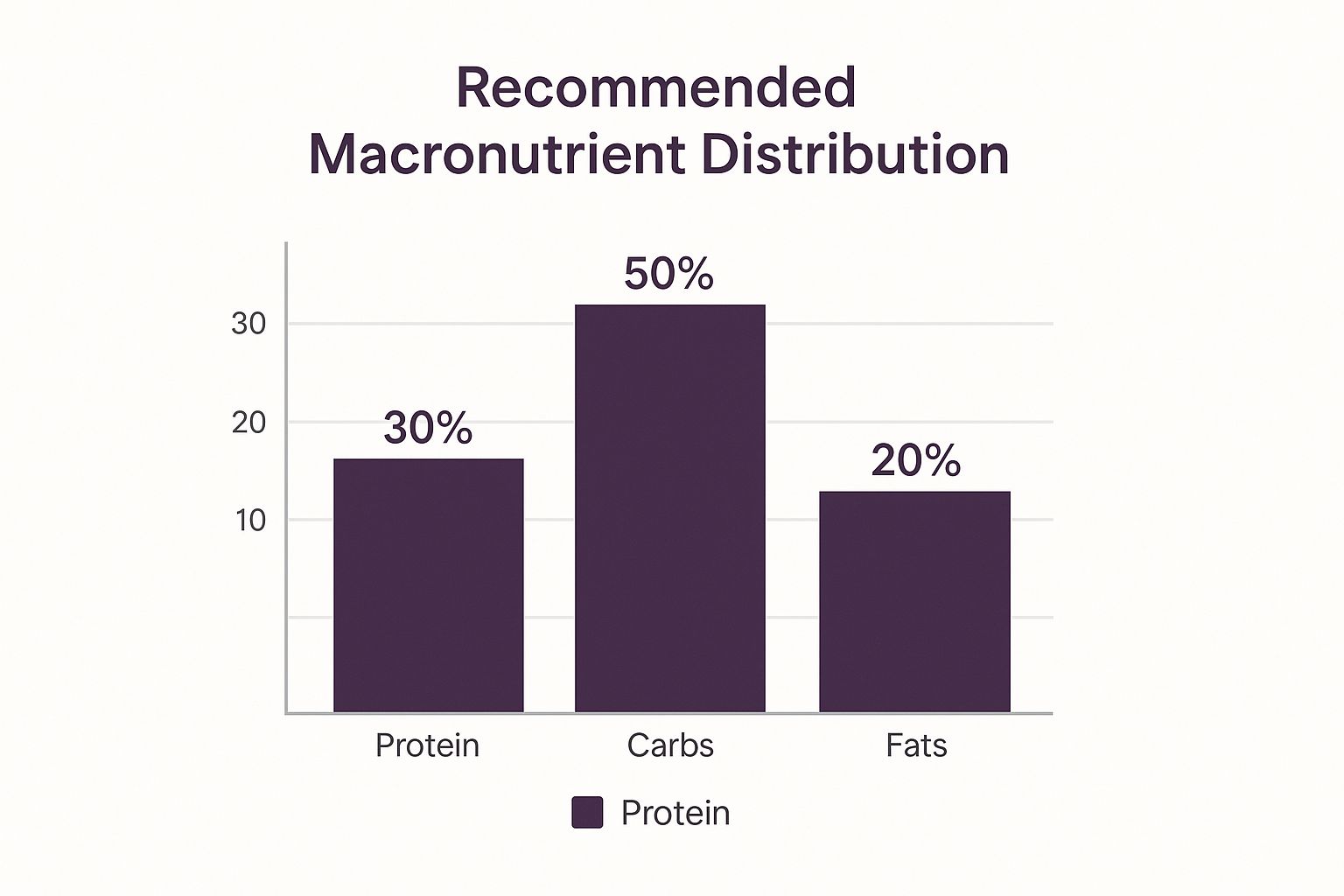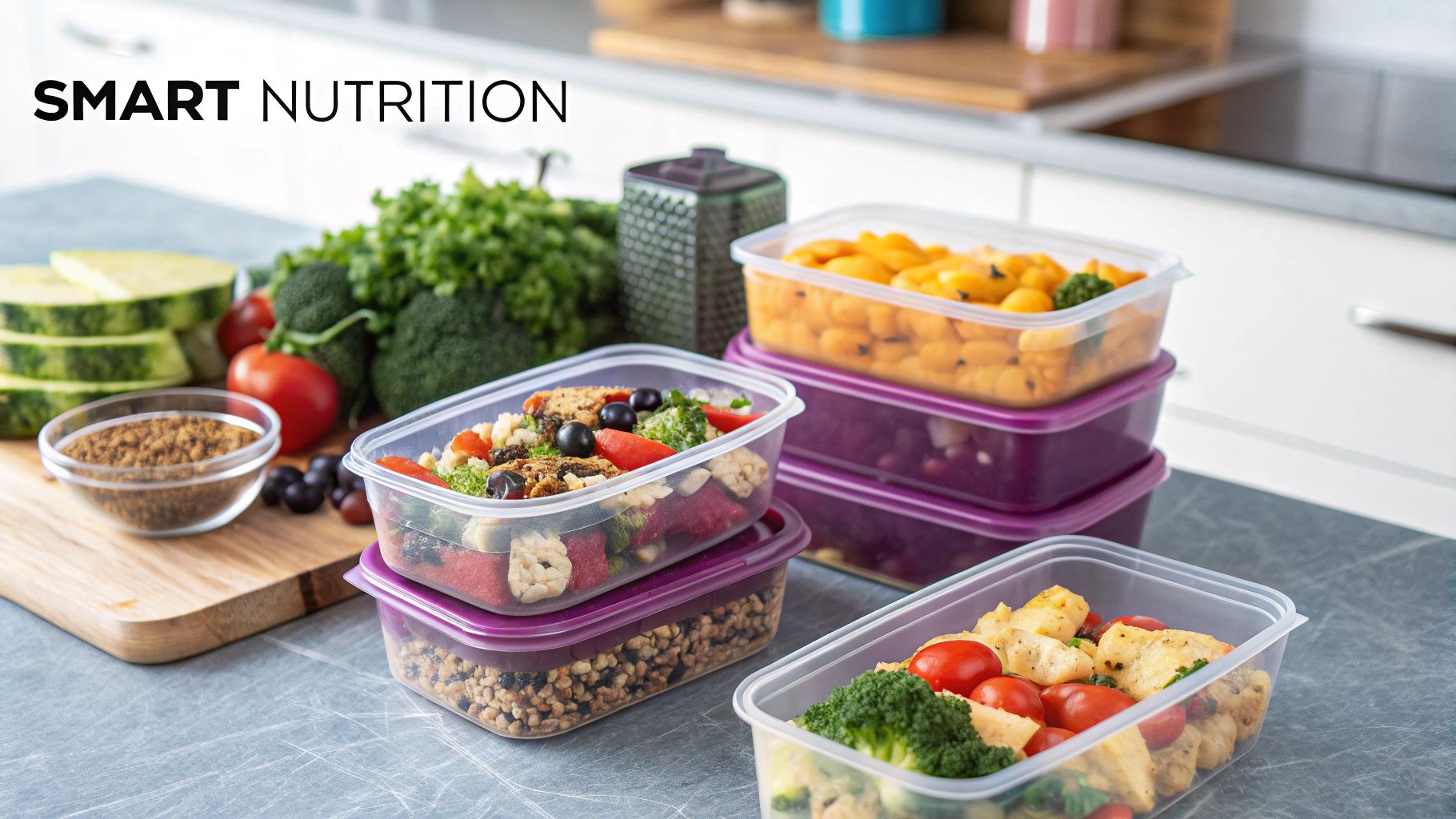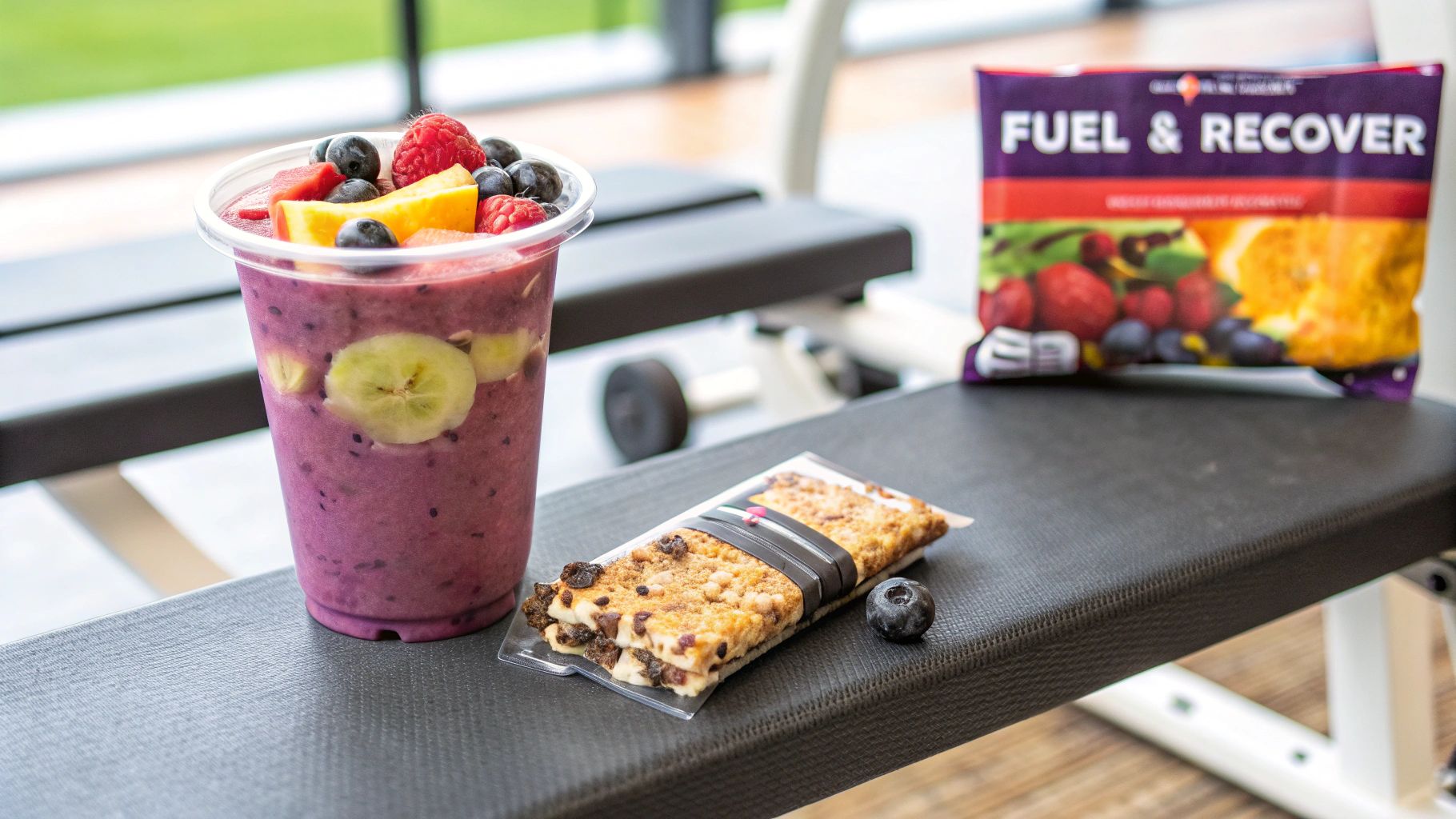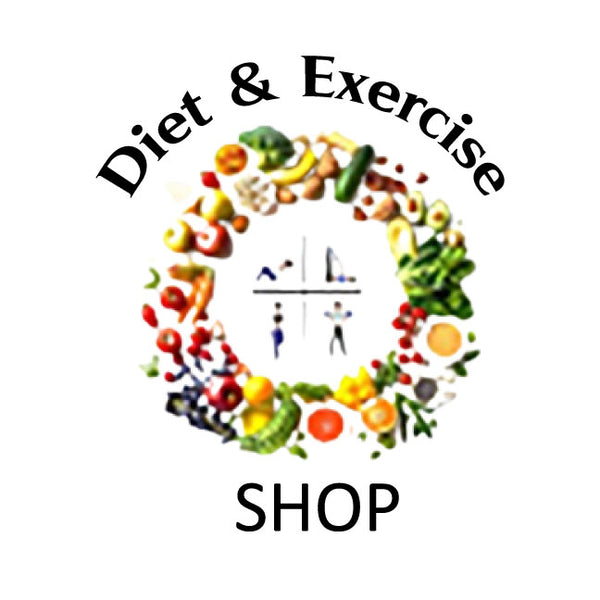
Balancing Diet and Exercise for Real Results
Achieving your fitness goals requires a smart, unified approach. At the heart of it all is the core principle of balancing diet and exercise. This isn't an "either/or" situation. Real, lasting results come from making your nutrition and your workouts a true team.
It’s this powerful synergy that turns all your hard work in the gym into noticeable progress.
Why Your Food and Fitness Plan Need to Be in Sync
A common myth is that you can out-train a bad diet. It just doesn't work that way. On the flip side, even the cleanest eating plan won't build strength or improve your cardio without the right exercise. The two are completely intertwined.
Think of it this way: your diet provides the fuel for performance and the raw materials for recovery. Exercise is the catalyst that tells your body how to use those nutrients—whether to build muscle, burn fat, or just power you through a tough workout.
This relationship is vital for a few key reasons:
- Fueling Your Engine: Carbs provide the high-octane fuel your muscles crave during exercise.
- Repairing and Rebuilding: Protein delivers the amino acids needed to rebuild muscle fibers stronger than before.
- Boosting Your Metabolism: Consistent exercise improves how your body manages blood sugar.
- Smarter Fat Loss: Combining a calorie deficit with exercise ensures you lose mostly fat while keeping muscle. Learn more in our guide on the benefits of exercise and healthy eating.
Nailing Your Macronutrient Intake
Your diet is built on three pillars: protein, carbohydrates, and fats. These are your macronutrients, and getting the right balance is everything for an active lifestyle.
This infographic gives a solid starting point for macronutrient ratios for general fitness.

As you can see, carbs usually take up the biggest slice to keep your energy levels topped off. Protein comes next for repair work, and healthy fats are crucial for hormones and overall health. An endurance runner's needs will differ from a bodybuilder's, but the principle of fueling for the task remains the same.
The fitness industry is massive, but many people still struggle. A practical plan that marries diet and exercise is the key to closing the gap between wanting to be fit and achieving it.
Building Your Personal Nutrition Plan
Think of your diet as the high-performance fuel that powers your body. Crafting a personal nutrition plan is the most critical step in getting your diet and exercise to work together. This is how you give your body the exact resources it needs to perform, recover, and transform.
Ditch the generic, one-size-fits-all advice. Your plan must be built around you—your unique goals, activity level, and lifestyle.

The process starts with understanding what your body actually needs. Someone training for a marathon has different fuel requirements than someone focused on packing on muscle. The secret is to align what you eat directly with what you do.
Nailing Down Your Calories and Macros
The bedrock of any solid nutrition plan is calories. You need to know if you should be in a calorie surplus (to build muscle), a deficit (to lose fat), or at maintenance.
But it’s not just about how much you eat; it’s about what you eat. Those calories need to come from a smart mix of macronutrients: protein, carbohydrates, and fats. Each one has a specific job to do.
- Protein: Essential for muscle repair and growth.
- Carbohydrates: Your body's number one energy source.
- Fats: Crucial for hormone production and nutrient absorption.
Figuring out the right ratio can feel intimidating, but it’s a game-changer. For a detailed walkthrough, check out our guide on how to calculate your macros.
Putting Together Balanced Meals That Match Your Goals
Once you have your numbers, the fun begins—translating them onto your plate. Create meals that hit your targets and are also satisfying and delicious. A plan you enjoy is a plan you'll stick with.
A meal for muscle gain will look different from a meal for fat loss, even with similar ingredients. It's all in the portions and balance.
Sample Meal Breakdown
| Goal | Protein Source | Carbohydrate Source | Healthy Fat Source |
|---|---|---|---|
| Muscle Gain | Grilled Chicken Breast (6oz) | Brown Rice (1.5 cups) | Avocado (1/2) & Olive Oil |
| Fat Loss | Baked Salmon (4oz) | Quinoa (1 cup) | Handful of Almonds |
| Endurance | Lean Ground Turkey (5oz) | Sweet Potato (1 large) | Chia Seeds (1 tbsp) |
See how that works? The core components are always there—lean protein, quality carbs, and healthy fats—but the amounts shift to meet different goals. Healthy eating doesn't have to be boring.
The Smart Way to Use High-Quality Supplements
Life is busy. Juggling work, family, and fitness can make it tough to hit your nutritional goals perfectly every day. This is where high-quality supplements can be a lifesaver. They’re here to support your diet, not replace it.
A post-workout protein shake is a simple, effective way to kickstart muscle recovery. Our Whey Protein Powders are designed for rapid absorption, getting essential amino acids to your muscles right when they need them most.

Likewise, a meal replacement shake can keep you on track on hectic days. It gives you a balanced mix of protein, carbs, and fats to keep you fueled. By using supplements to strategically fill the gaps, you eat smarter and set yourself up for success.
Designing a Workout That Supports Your Diet
Exercise isn't just a calorie-burning machine. It's how you build a stronger, more resilient, and more capable body. To get real results, your workout plan and your nutrition must be in sync—working together, not against each other.
This is where we get practical. We’ll walk you through building a routine that complements your diet by focusing on the three essential pillars of fitness: cardio, strength, and flexibility.

The goal is to stop just "working out" and start training with intent. Every session should be a deliberate move towards your goal, whether that's shedding fat, packing on muscle, or simply feeling better.
Combining Diet and Exercise for Your Goals
Your workout schedule needs to directly reflect your nutrition strategy. A routine for fat loss will look very different from one designed for muscle gain. Here’s how to combine diet and exercise for the most common goals.
Goal: Fat Loss
For fat loss, you’ll be in a calorie deficit. Your training must maximize calorie burn while preserving lean muscle. A great combination is steady-state cardio paired with total-body strength training.
- Diet: A moderate calorie deficit with high protein intake.
- Exercise: 3 days of full-body strength training and 2-3 days of cardio (jogging, cycling, or HIIT).
- Supplements: Whey Protein Powders post-workout help preserve muscle mass while you're in a deficit.
This schedule keeps your metabolism revved up. Muscle is metabolically active tissue; it burns calories even when you're resting.
Goal: Muscle Gain
To build muscle, you need a calorie surplus. Your job in the gym is to give those extra calories a purpose—to be used for muscle growth, not just stored as fat. This requires a sharp focus on progressive overload.
- Diet: A moderate calorie surplus with high protein and sufficient carbs for energy.
- Exercise: A 4-5 day split routine (e.g., upper/lower body) focusing on lifting heavier over time.
- Supplements: Our Pre-Workout Supplements deliver a clean burst of energy and focus for intense sessions. The added BCAAs also help protect muscle tissue.
This kind of split lets you hammer each muscle group with enough volume to signal real growth. Rest days are crucial—that’s when muscle repair and rebuilding actually happens.
Mastering Pre and Post Workout Nutrition
What you eat right before and after the gym can completely change your results. This is about smart timing to make sure your body has the right fuel when it needs it most—a core principle of balancing diet and exercise.
Your pre-workout meal is like topping off the gas tank. Your post-workout meal is the pit crew that repairs and refuels everything for the next race. Both are crucial.
Fueling Up for Peak Performance
A pre-workout meal gives you sustained energy to push harder and last longer. Focus on easily accessible carbohydrates and a little protein. Aim to eat about 30-60 minutes before your workout.
Here are a few great pre-workout options:
- A small banana with a spoonful of peanut butter
- A small bowl of oatmeal with berries
- A piece of toast with honey
These choices provide the immediate glycogen your muscles need to power through intense workouts. It helps you avoid that awful mid-workout crash.
The Critical Post-Workout Recovery Window
The second your workout ends, the clock starts on recovery. Right after exercise, your muscles are primed to soak up nutrients like a sponge. This is your best chance to refill energy stores and deliver materials for muscle repair.
Your body needs two things: fast-absorbing protein and simple carbohydrates. The protein repairs muscle, and the carbs create an insulin spike that helps shuttle nutrients into the muscle cells more efficiently. This one-two punch is proven to reduce muscle soreness and speed up recovery. For more on this, check out "5 Post-Workout Mistakes You're Making" on our channel.
Perfecting Your Post-Workout Meal
After a workout, you need something your body can absorb fast. This is where a high-quality protein shake becomes your best friend.
A top-tier whey protein is a fantastic choice because it's packed with essential amino acids and digests quickly. Our Diet & Exercise Premium Whey Protein was formulated specifically for this purpose—maximum absorption to get fuel to your muscles right when they need it. A single scoop mixed with water or milk is all it takes.
Some other great post-workout recovery options include:
- A protein shake: Mix protein with a banana and your choice of milk.
- Chocolate milk: A surprisingly effective option with a great carb-to-protein ratio.
- Greek yogurt with fruit: A solid dose of protein and quick carbs.
By nailing your pre- and post-workout nutrition, you create a powerful cycle of fuel, performance, and recovery.
Breaking Through Plateaus and Staying Motivated
It happens to everyone. The progress that was coming so consistently suddenly hits a brick wall. This is a plateau. While frustrating, it’s a completely normal part of any fitness journey. A plateau is a sign of success—your body has mastered the old routine and needs a new challenge.
Why Does Progress Stall?
Plateaus happen for real physiological reasons. One is metabolic adaptation. As you lose weight, your body needs fewer calories to operate. Your metabolism cleverly slows down to match your new, lighter weight.
Another culprit is the slow return of old habits. A few extra calories can creep back into your diet, or your workout intensity can dip without you even noticing.
Smart Strategies to Reignite Your Results
When you hit a wall, don't just try harder at what's already stopped working. It's time to shake things up. This is a critical moment in balancing diet and exercise.
Here are a few proven strategies:
- Try Carb Cycling: Vary your carb intake. Plan higher-carb days around your toughest workouts and lower-carb days on rest days.
- Change Your Training Style: Been doing steady-state cardio? Throw in some HIIT. Been lifting in the 8-12 rep range? Switch to a strength block with heavier weight and lower reps (4-6).
- Do an Honest Diet Audit: For one week, track everything you eat and drink. Be brutally honest.
A plateau isn't a stop sign; it's a yield sign. It’s telling you to pause and choose a smarter path forward.
Looking Beyond the Scale for True Progress
Staring at a number on the scale is one of the fastest ways to kill your motivation. True progress is so much more than a single number. To see the full picture, you have to track more than just your weight.
This is where fitness tech can be a game-changer. Our collection of Smart Scales and Fitness Trackers is designed to give you clarity. A good smart scale goes beyond weight and can show you trends in body fat percentage and muscle mass.
Here’s why tracking these metrics is so crucial:
- Body Recomposition is Real: You could be gaining muscle while losing fat, but the scale might barely move.
- Performance is Progress: Lifting more weight or running faster are undeniable signs of getting fitter.
- The Fit of Your Clothes: A favorite pair of jeans feeling looser is real-world proof that what you're doing is working.
Using tools like a fitness tracker and a smart scale gives you a richer story of your progress, helping you celebrate all the small victories.
Got Questions? We've Got Answers
When you're trying to sync up your diet and your workouts, a lot of questions pop up. It's totally normal. Here are some of the most common ones.
Diet vs. Exercise: What's the Real King of Weight Loss?
If we're talking purely about dropping pounds, your diet has the upper hand. It's much easier to cut 500 calories from your daily intake than to burn that same amount in the gym. The old saying, "You can't outrun a bad diet," holds true.
But that's only half the story. Exercise shapes your body, helps you keep valuable muscle while losing fat, and keeps your metabolism humming. The best results always come from a smart combination of both.
Am I Eating Enough to Fuel My Training?
Your body is pretty good at telling you what it needs. Are you constantly dragging? Is your performance in the gym tanking? Are you sore for way longer than usual? These are classic signs you might be under-fueling.
Hitting a wall mid-workout is another huge red flag. A good first step is to bump up your calorie intake slightly with some quality complex carbs. This helps top off your energy stores.
Can You Really Build Muscle and Lose Fat at the Same Time?
Yes, you absolutely can! It’s a process called body recomposition, and it works best for people who are relatively new to lifting weights. The catch is that you have to be very strategic about it.
It requires a delicate balance: a small calorie deficit, a high-protein diet, and a challenging strength training program. It's a slower road than focusing on one goal at a time, but it is possible.
How Often Should I Have a Cheat Meal?
This comes down to you, your goals, and what keeps you sane. For many, one "off-plan" meal a week provides a needed mental break and can help you stick to your plan long-term.
A more strategic version is a "refeed day," a planned increase in calories (mostly from carbs) after a long period of dieting. This can help boost your metabolism. Find what works for you—something that keeps you happy and motivated while still making progress.
At Diet & Exercise, we believe fitness should be fun and accessible. Check out our unique collection of Fitness-Themed Coloring Books for a creative way to relax and stay motivated on your journey.
